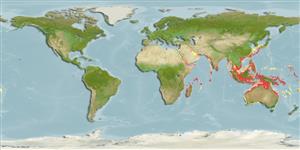Environment: milieu / climate zone / depth range / distribution range
Ökologie
seewasser; brackwasser demersal; tiefenbereich 20 - 60 m (Ref. 83903). Tropical
Indo-West Pacific: Pakistan, India and Sri Lanka, extending eastward to Indonesia. Recorded from the Gulf (Ref. 37588); also from northwestern Australia northward to Japan.
Size / Gewicht / Alter
Maturity: Lm ? range ? - ? cm
Max length : 22.0 cm TL Männchen/unbestimmt; (Ref. 3470); common length : 14.0 cm TL Männchen/unbestimmt; (Ref. 3470)
Rückenflossenstacheln (insgesamt) : 8; Rückenflossenweichstrahlen (insgesamt) : 9; Afterflossenstacheln: 1; Afterflossenweichstrahlen: 7 - 8. This species is distinguished by the following characters: D VIII,9; pectoral fins 13-14; gill rakers 4-5 + 14-15 = 18-20; lateral line scales 31-34; body depth at first dorsal fin origin 25-28% SL and at anal-fin origin 22-24% SL; caudal-peduncle depth 11-13% SL; maximum head depth 21-23% SL; head depth through eye 17-20% SL; head length 27-30%SL; orbit length 6.1-7.2% SL; upper jaw length 11-12% SL; barbel length 18-21% SL; caudal-fin length 26-29% SL; anal-fin height 16-18% SL; pelvic-fin length 20-23% SL; pectoral-fin length 21-23% SL; first dorsal-fin height 25-29% SL; second dorsal-fin height 16-18% SL; 5-6 weak, red or grey bars on upper caudal fin lobe (not retained on preserved fish); no bars on lower lobe, fully to partly covered with a reddish or greyish band (lost in preserved fish); a pale brown mid-lateral body stripe from behind eye to caudal-fin base (sometimes retained in preserved fish); no dark dorsal-fin tip; yellow barbels when fresh; body reddish or dark grey dorsally, whitish-rose ventrally; head with red or grey pigmentation at snout and above eyes (body may darken dorsally in preserved fish (Ref. 83903).
Inhabits coastal waters down to 100 m. Usually occurs in schools. Feeds on benthic animals (Ref. 2110).
Life cycle and mating behavior
Maturities | Fortpflanzung | Spawnings | Egg(s) | Fecundities | Larven
Uiblein, F. and P.C. Heemstra, 2010. A taxonomic review of the Western Indian Ocean goatfishes of the genus Upeneus (Family Mullidae), with descriptions of four new species. Smithiana 11:35-71. (Ref. 83903)
IUCN Rote Liste Status (Ref. 130435)
Bedrohung für Menschen
Harmless
Nutzung durch Menschen
Fischereien: kommerziell
Tools
Zusatzinformationen
Download XML
Internet Quellen
Estimates based on models
Preferred temperature (Ref.
123201): 24.1 - 28.6, mean 27.7 °C (based on 409 cells).
Phylogenetic diversity index (Ref.
82804): PD
50 = 0.5000 [Uniqueness, from 0.5 = low to 2.0 = high].
Bayesian length-weight: a=0.00832 (0.00504 - 0.01373), b=3.04 (2.90 - 3.18), in cm total length, based on LWR estimates for this species & Genus-body shape (Ref.
93245).
Trophic level (Ref.
69278): 3.5 ±0.37 se; based on food items.
Widerstandsfähigkeit (Ref.
120179): hoch, Verdopplung der Population dauert weniger als 15 Monate. (Preliminary K or Fecundity.).
Fishing Vulnerability (Ref.
59153): Low vulnerability (12 of 100).
